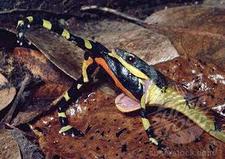Honest Signals
Biology 342 Fall 2015
Mikela Sheskier and Shirin Porkar-Aghdam
O N T O G E N Y
D E V E L O P M E N T
How did the behavior come to be throughout the lifetime of the individual?
Aposematism in Granular Poison Frogs:
[untitled image of Leimadophus epinephelus eating a poisonous frog] retrieved November 28, 2015 from: https://oceans4-11.wikispaces.com/Poison+Arrow+FrogHow do predators learn to associate bright colors with increased toxicity? Aposematism relies on the conditioned memory of the predator for the association between bright coloration and noxious taste (Maan & Cummings., 2012). The association is kept consistent and does not attenuate over time as granular frogs, and most species that employ aposematism as an honest signal towards predators, are gregarious species facilitating the chance that the connection will be reinforced through repetition (Maan & Cummings., 2012). An association between conspicuousness and distastefulness can be learned quickly in most predatory species, including birds of prey that typically feed on granular frogs, with acquisitioning seen in one-trial avoidance learning procedures (Roper et al., 1987). |
Stotting:
[A female springbok (Antidorcas marsupialis) caring for its young] retrieved November 29, 2015 from:http://www.arkive.org/springbok/antidorcas-marsupialis/image-G28046.htmlStotting as a method of evading predators is reinforced in the lifetime of the organism. In Thomson gazelles studies have shown that the gazelles that outran the predators were the same gazelles that stotted more and for longer durations (FitzGibbon et al. 1988). Furthermore, the offspring of mothers that stott more have a higher chance of survival than those of mothers that don't due to the function of stotting as a distractor (Caro et al. 1986). This may greatly influence to what extent the offspring learns to increase its stotting behavior as an adult, through social learning. The stotting itself acts as a conditioned stimulus for predators that signalls that the stotter is not worth pursuing. The purpose of stotting also changes throughout the lifetime of the organism. For the young its mostly directed towards the mother to signal a disturbance or used for play with other young conspecifics (FitzGibbon et al. 1988).
|

